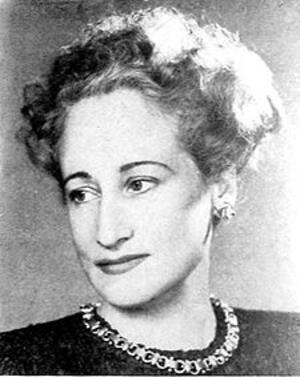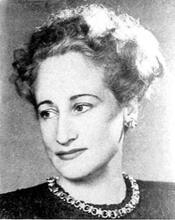Vera Caspary
Vera Caspary began her career as a stenographer, copywriter, and as the editor of Dance Magazine from 1925–1927. In 1929, she published her first novel, The White Girl, which was praised for its portrayal of a Black woman who moves to Chicago and passes as white. During her prolific career, Caspary wrote twenty novels, five plays, an autobiography, a collection of short stories, and countless screenplays. Her best-known work, Laura, a murder mystery with a complex plot and characters, is considered the first psychothriller. The 1944 film based on the book and directed by Otto Preminger was incredibly popular and has become a classic. The female characters in Caspary’s novels and plays are strong, emancipated women, and her own concern with issues of prejudice and class consciousness are reflected in her works.
Overview and Early Career
Novelist and screenwriter Vera Caspary wrote in her autobiography, The Secrets of Grown-Ups (1979): “This has been the century of The Woman and I know myself fortunate to have been part of the revolution. In another generation, perhaps the next, equality will be taken for granted. Those who come after us may find it easier to assert independence, but will miss the grand adventure of having been born a woman in this century of change.”
Vera Louise Caspary was born on November 13, 1899, in Chicago, Illinois, the daughter of Paul and Julia (Cohen) Caspary. Her paternal grandfather fled Germany during the 1848 Revolution. Her maternal grandfather emigrated from Amsterdam by way of England. She had a sister, Irma, fifteen years her senior, and two older brothers, Arthur and Danny. Her father was a buyer for a department store. Caspary was educated in Chicago public schools. On October 5, 1949, she married I.G. Goldsmith, a film producer born in Vienna.
Caspary worked as a stenographer, a copywriter, the director of a mail order school for such courses as ballet lessons and writing photoplays (before writing any of her own), the editor of Dance Magazine (1925–1927), and a free-lance author and screenwriter from 1927 until her death. She wrote twenty published novels and was a prolific screenwriter for Hollywood films.
In her best-known work, Laura, first written as a novel, Caspary went beyond the traditional murder mystery. With its brilliantly constructed plot involving complex characters interacting on multilevels, this might well be considered the first psychothriller. The 1944 film, directed by Otto Preminger and starring Gene Tierney in the title role, has become a classic. She received awards from the Screen Writers Guild in 1948 for A Letter to Three Wives and in 1967 for Les Girls.
Themes and Later Work
Caspary was an unconventional, independent woman, despite her conventional, Jewish middle-class background. She supported herself, and later her widowed mother, at a time when few women had careers of their own. The female characters in her novels and plays are strong, emancipated women. Her analyses of what drives her villains and victims alike are objective and evenhanded. In her screenplays, Caspary displayed an apt ear for dialogue and allowed the characters to reveal themselves through their own words and actions, producing realistic portraits on a wide range of social levels. Beginning with her first novel, The White Girl (1929), about an African-American woman who moves north to Chicago, where she passes as white, Caspary concerned herself with issues of prejudice and class consciousness in twentieth-century America.
Her autobiography provides a sensitive yet unsentimental retrospective of the twentieth century, highlighting such broad topics as the New York scene of the roaring twenties, gangster Chicago, the world in the grip of the Depression, American intellectuals embracing (and becoming disillusioned by) communism, the romanticizing of the Spanish Civil War, Hollywood studios, London during World War II, the first reactions to the concentration camps, postwar Europe, and Hollywood in the McCarthy era.
Caspary described herself and her husband as two who “scorned the practice of religion but shared contempt for Jews who denied their heritage.” Her respect for that heritage shows in her insistence on the dignity of all. It adds poignancy to her community’s reaction to the Leopold-Loeb murder case, to her description of the atmosphere in Britain following the victory brought by the bombings of Hiroshima and Nagasaki, and to her encounter with a bigoted Texan on her return voyage to America after the war. And that heritage surely fostered her proud independence. The characters Caspary created and the life she lived do indeed define “the grand adventure of having been born a woman in this century of change.”
Vera Caspary died of a stroke on June 13, 1987.
Selected Works by Vera Caspary
Novels
Bedelia (1945).
A Chosen Sparrow (1964).
The Dreamers (1975).
Elizabeth X (1978).
Evvie (1960).
False Face (1954).
Final Portrait (1971).
The Husband (1957).
Ladies and Gents (1929).
Laura (1943).
The Man Who Loved His Wife (1966).
The Murder in the Stork Club (1946).
Music in the Street (1930).
The Rosecrest Cell (1967).
Ruth (1972).
Stranger Than Truth (1946).
Thelma (1952).
Thicker Than Water (1932).
The Weeping and the Laughter (1950), republished as The Death Wish (1951).
The White Girl (1929).
Autobiography
The Secrets of Grown-Ups (1979).
Plays
Blind Mice, with Winifred Lenihan (1930).
Geraniums in My Window, with Samuel Ornitz (1934).
Laura, with George Sklar (1945).
Wedding in Paris (1954).
Screenplays
Bachelor in Paradise (1961).
Bedelia (1946).
The Blue Gardenia, with Charles Hoffman (1953).
Claudia and David, with Rose Franken and William Brown Meloney (1946).
Easy Living, with Preston Sturgis (1937).
Les Girls, with John Patrick (1957).
Give a Girl a Break, with Albert Hackett and Frances Goodrich (1954).
I Can Get It for You Wholesale, with Abraham Polonsky (1951).
I’ll Love You Always (1935).
Lady Bodyguard, with Edmund L. Hartmann and Art Arthur (1942).
Lady from Louisiana, with others (1941).
A Letter to Three Wives, with Joseph L. Mankiewicz (1949).
Out of the Blue, with Walter Bullock and Edward Eliscu (1947).
Scandal Street, with Bertram Millhauser and Eddie Welch (1938).
Service Deluxe, with others (1938).
Sing, Dance, Plenty Hot, with others (1940).
Three Husbands, with Edward Eliscu (1950).
Evory, Ann, and Linda Metzger, eds. Contemporary Authors. New Revision
Series. Vol. 9 (1983).
Kinsman, Clare D., ed. Contemporary Authors. Vols. 13–16 (1975).
Obituary. NYTimes, June 17, 1987; Reilly, John M., ed. Twentieth-Century Crime
and Mystery Writers (1980).
Rothe, Anna, ed. Current Biography (1948).
UJE.




